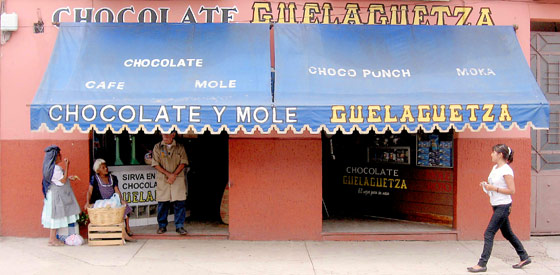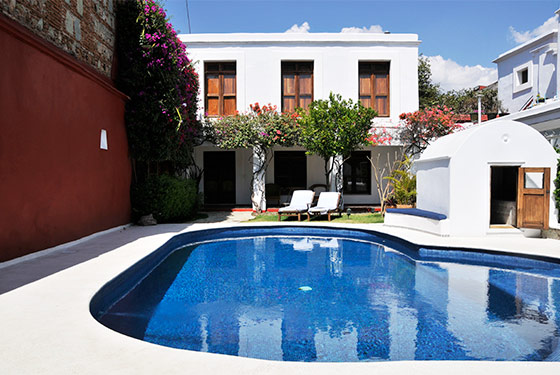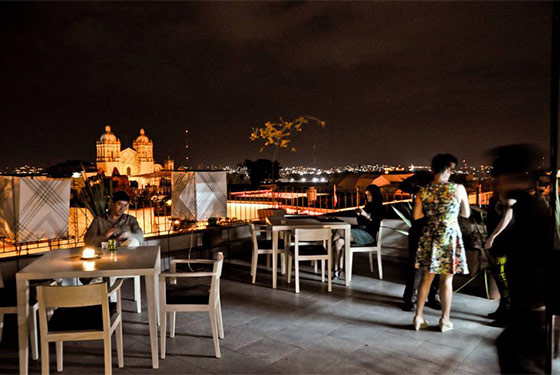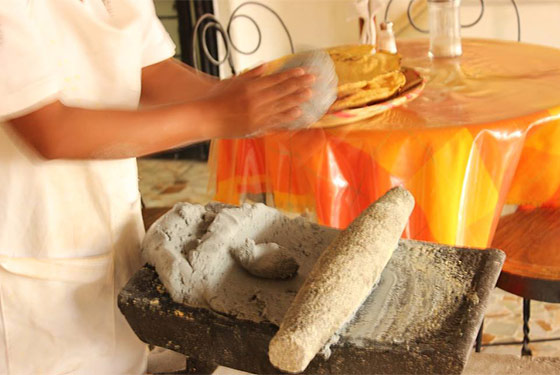 |
(Photo: 16:9clue via Flickr) |
Soak up modern Mexican vibes at Hotel Azul (from $167), an early 19th-century compound turned 21-room boutique hotel with suites designed by notable Oaxacan artists like Luis Zárate, the Fríjol Parado collective, and Francisco Toledo. Marvel at the geometric patterns, playful accents, and designer floor tiles in your room as you sip a welcome mezcal; then, relax in the Toledo-designed rear courtyard. Browse art books and prints in the first-floor gallery and, on weekends, head up to the open-air terrace for live jazz and marimba music.
 |
Chill by the heart-shaped pool at Casa Oaxaca.
(Photo: Courtesy of Casa Oaxaca) |
Book a room with a view of the heart-shaped pool at tranquil Casa Oaxaca (from $151), an intimate inn whose eponymous restaurant, located just a few blocks away, happens to be one of the best in Latin America. Request a spot in a cooking class when you make your reservation, so you can accompany executive chef Alejandro Ruiz or his second-in-command on their daily market rounds and learn a few of their best recipes ($160 per person). Book a shaman-led session in the poolside temazcal (a pre-Hispanic sweat lodge), or curl up with a book in the cozy library.
Live like a local at El Diablo y la Sandia (from $80), a cheery six-room B&B run by a mother-daughter team. The décor is inspired by Mexico’s kitschy lotería cards; ask for the upstairs room, which gets nice light streaming in through the windows and opens onto the rooftop garden terrace, where you can lounge in a shady hammock and maybe catch a glimpse of the resident bunny, Siggy. Grab a seat at the communal table in the courtyard and watch your daily breakfast being prepared in the open kitchen; in the evening, help yourself to a mezcalito from the honor bar in the sitting room. The owners give out maps of the neighborhood along with great local recommendations, and also offer bikes for rent.
Dig into contemporary Mexican at Pitiona, where a young chef who’s worked at Spain's El Bulli whips up imaginative dishes with names like “the cow that wished it was a goat” (a cut of beef paired with goat cheese, $24). Get the suckling pig tacos, each crowned with a chicharrón crumble ($19), and don’t leave without trying the buñuelo with quesillo mousse ($7.50), a disc of buttery pastry topped with a cloud of whipped Oaxacan cheese, candied citrus, dainty rounds of meringue, and edible flowers.
 |
Mingle over potent cocktails on Mezquite's rooftop.
(Photo: Courtesy of Mezquite) |
Watch the city lights twinkle from your perch on the open-air rooftop terrace at Mezquite. Order a picantemezcal punch ($5) with pomegranate, mint, and chile de agua, along with one of the kitchen’s elevated takes on Oaxacan classics, like grasshopper tacos with quesillo ($6), tlayuda with chorizo ($8), or octopus ceviche ($6). On your way out, stop to admire the dramatically lit textured brick installation above the downstairs bar.
Get experimental at Luvina, a “workshop” kitchen focused on pushing the boundaries of flavor and texture in traditional Mexican dishes. Try the “spherified” tortilla soup ($5), squash-blossom tortellini with coriander foam ($10.50), or the liquid quesadilla with pulque sauce (available as part of a $35 tasting menu). Or just hang in the courtyard bar and take in the stylish space’s decorative floor tiles and wall sculpture made of reclaimed wood off-cuts, while sipping a Mexican craft brew like Boca Negra ($4).
Learn to make signature dishes like mole colorido during a cooking class ($75) at the home of Pilar Cabrera, chef at La Olla restaurant and owner of Casa de los Sabores cooking school. Tag along as she wends her way through the stalls at Mercado de la Merced, picking up ingredients for the four-course menu you’ll prepare at her bright, art-filled home. Ask about her occasional street-food tours, which take visitors out to the dynamic markets in Oaxaca’s outlying villages to sample the plates that made the region famous, from airy corn tamales to tlayudas, a sort of pre-Hispanic pizza.
 |
On Calle Mina, get your hands dirty making chocolate from scratch.
(Photo: Courtesy of Casa de los Sabores) |
Grind your own custom Mexican drinking chocolate on Calle Mina’s “chocolate block” (Francisco Javier Mina between Miguel Cabrera and 20 de Noviembre), home to a handful of small storefronts where you can watch as chocolate is ground fresh from the toasted cacao pod in old-fashioned mills. Take a sampling spoon to the freshly made tubs of dark, almond, and milk chocolate, still warm from the grinder, that line the counter at La Soledad, or make your own blend ($11). Afterwards, let your nose guide you around the corner toward the Mercado 20 de Noviembre’s taco corridor, where comedors like La Abuelita serve traditional plates like tasajo (grilled beef) tlayudas and bakery stalls sell traditional pan de yema (egg bread).
Get an agave education. Join an excursion to the fields outside of town with mezcal expert Alvin Starkman to see firsthand how the spirit is made by mom-and-pop producers; you can even help a Zapotec family harvest the aguamiel (agave sap) that is later fermented to make pulque. Or get truly agave-academic at Mezcaloteca, a nonprofit (that looks an awful lot like a bar) devoted to teaching the public about the wonders of mezcal. English-speaking barkeeps will explain how to tell the good stuff from the industrial mezcal increasingly flooding the market, and how to smell, taste, and savor the spirit as you would a wine ($10.50 for three samples; reservations required). Afterwards, test out your newly sophisticated palate at any of the dozens of mezcal bars around town; the best are In Situ, where prophet of mezcal Ulises Torrentera presides over some 180 varieties; Piedra Lumbre, a hipster speakeasy–cum–art gallery; and Zandunga, a colorful space with mezcal-inspired inscriptions on the walls.
From Ron Cooper, founder of Del Maguey mezcal:
 |
At Itanoní, a Slow Food devotee offers a deep education on the world of Mexican corn.
(Photo: Courtesy of Itanoní) |
“Marco Polo is a seafood restaurant that makes a killer butterfly huachinango (red snapper). It goes into a wood-fired adobe horno, which is like a pizza oven, for four minutes, and it’s the most delicious dish I’ve ever had.”
“Two brothers from Mexico City, Fernando and Nacho, have this place La Biznaga with very cool cocktails and fresh pulque, an amazing menu, and great soundtracks. Fernando does the restaurant; Nacho does the music—completely contemporary, very diverse tunes. Ask for a mezcal negroni.”
“Itanoní is a project from an agronomist who has been recognized by Slow Food. He and his wife present unhybridized corn and vegetables from many different regions of Oaxaca, which has 500,000 varieties of corn. It’s the high-end of Oaxacan street-casual cuisine.”
“La Farola (Av. 20 de Noviembre, near Mercado Juarez) is a real traditional bar downtown where they serve free botanas (snacks) with drinks. It’s frequented by newspaper writers, and Malcolm Lowry is said to have written part of Under the Volcano there.”
“Central de Abastos is the major market every Saturday. Be sure to go and eat the caldo de chivo (goat soup) in the booth of a woman from Tlacolula, near the flower stalls; her name is Flor.”
When you land, pick up Arrecife, a bilingual culture and lifestyle magazine covering all that’s new and cool in Oaxaca.
Check out the Que Pasa Oaxaca blog for events listings and more, in English.
To bone up on your mezcal knowledge before your trip, click over to the Mezcalistas, an English-language blog devoted to all things agave, run by a couple of mezcal-obsessed writers from San Francisco.